Exploring high trees and wild beaches
Pemberton - Walpole-Nornalup NP - William Bay NP - Albany - Torndirrup NP - Fitzgerald River NP - Esperance
Click on a picture to enlarge. These pages show only a small selection of the 400 pictures of Australia. Order the CD to view all pictures full screen (800 x 600 pixels) and to enjoy the slide shows with original music! The CD offers you also the complete interactive story, suitable for quick viewing and printing.
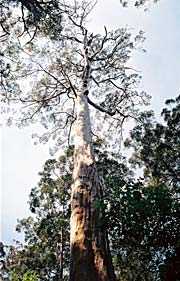 Huge
forests with towering trees stretch endlessly out around Pemberton in the uttermost
South West of Australia. At least, to us it looks endlessly but as a result
of the activities of the timber industry there is only a fraction of the trees
left. Luckily in the last century trees have been planted also, the Beedelup
NP for example was totally destroyed but regrown in the last 100 years. In Pemberton,
the center of the logging industry, a heated discussion is ongoing between the
logging industry and environmental activists. The timber industry – from which
this area is for a large part economically dependent – claims their low impact
logging policy ensures the continuance of the forests. The environmental activists
try to protect the remaining old-growth forests and explain it takes centuries
to recreate what is destroyed. You simply cannot replace
Huge
forests with towering trees stretch endlessly out around Pemberton in the uttermost
South West of Australia. At least, to us it looks endlessly but as a result
of the activities of the timber industry there is only a fraction of the trees
left. Luckily in the last century trees have been planted also, the Beedelup
NP for example was totally destroyed but regrown in the last 100 years. In Pemberton,
the center of the logging industry, a heated discussion is ongoing between the
logging industry and environmental activists. The timber industry – from which
this area is for a large part economically dependent – claims their low impact
logging policy ensures the continuance of the forests. The environmental activists
try to protect the remaining old-growth forests and explain it takes centuries
to recreate what is destroyed. You simply cannot replace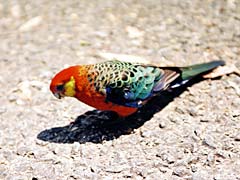 trees that are 500 years old. Furthermore, by killing the trees you also destroy
the life underneath, protected by the trees. The trees grow up to more than
60 meters and every part has its specific plants, animals and birds. The forests
consist of jarrah, marri and karri trees – please don’s ask which is which.
We have been studying the differences explained on informative signs on short
educational walks in different NP’s, but especially the difference between so-called
red karri trees (the straightest, highest trees) and red tingle (id) eludes
me. I even thought these two different names where intermittently used for the
same kind of tree, but this doesn’t seem to be the case. It are both eucalyptus
trees? If you know the distinction, please e-mail me!
trees that are 500 years old. Furthermore, by killing the trees you also destroy
the life underneath, protected by the trees. The trees grow up to more than
60 meters and every part has its specific plants, animals and birds. The forests
consist of jarrah, marri and karri trees – please don’s ask which is which.
We have been studying the differences explained on informative signs on short
educational walks in different NP’s, but especially the difference between so-called
red karri trees (the straightest, highest trees) and red tingle (id) eludes
me. I even thought these two different names where intermittently used for the
same kind of tree, but this doesn’t seem to be the case. It are both eucalyptus
trees? If you know the distinction, please e-mail me!
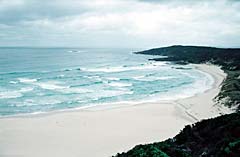
In the ‘Valley of the Giants’, Walpole-Nornalup NP, we do the
‘Tree top walk’. A metal structure 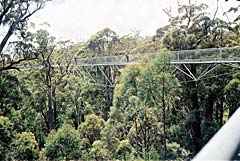 has
been erected between the giant trees, the highest point is at a height of 64
meters and offers a spectacular view far away over the tree tops. It is like
walking on clouds. The structure slowly sways in the wind and while walking
you can look through the metal grating straight to the far below ground – this
walk is suitable for wheelchairs
has
been erected between the giant trees, the highest point is at a height of 64
meters and offers a spectacular view far away over the tree tops. It is like
walking on clouds. The structure slowly sways in the wind and while walking
you can look through the metal grating straight to the far below ground – this
walk is suitable for wheelchairs 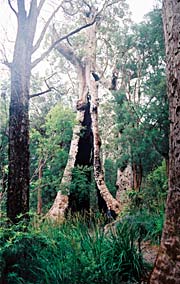 but
not for people with fear of heights! Ah, do I see a trifle superior smile? Then
you should try the Gloucester Tree ascend in Cloucester NP, close to Pemberton.
You can climb a tree of a mere 60 meters high, a climb which is ‘not for the
faint-hearted’ as the Lonely Planet puts it. A staircase consisting only of
metal sticks fixed in the stem winds itself higher and higher. Around it small-mesh
wire-netting, obviously intended as a kind of safety net, fails totally in creating
a feeling of safety. After reading ‘not for the faint-hearted’ in the LP I had
to climb the tree of course. But Jac, while explaining I must certainly do what
I wanted,
but
not for people with fear of heights! Ah, do I see a trifle superior smile? Then
you should try the Gloucester Tree ascend in Cloucester NP, close to Pemberton.
You can climb a tree of a mere 60 meters high, a climb which is ‘not for the
faint-hearted’ as the Lonely Planet puts it. A staircase consisting only of
metal sticks fixed in the stem winds itself higher and higher. Around it small-mesh
wire-netting, obviously intended as a kind of safety net, fails totally in creating
a feeling of safety. After reading ‘not for the faint-hearted’ in the LP I had
to climb the tree of course. But Jac, while explaining I must certainly do what
I wanted,  added
uncharacteristically that he would feel very sorry for himself if our three
months holiday where to end dramatically already at day 13. This sounded a bit
unlucky and I started to feel guilty, Jac already complained about the camping
facilities and about my tight planning and three months holiday wasn’t exactly
his idea. I didn’t want to appear too much pushing (me, pushing?). So we did
the Tree top walk instead, the view is probably even more beautiful but the
‘climb’ is certainly a little less exciting!
added
uncharacteristically that he would feel very sorry for himself if our three
months holiday where to end dramatically already at day 13. This sounded a bit
unlucky and I started to feel guilty, Jac already complained about the camping
facilities and about my tight planning and three months holiday wasn’t exactly
his idea. I didn’t want to appear too much pushing (me, pushing?). So we did
the Tree top walk instead, the view is probably even more beautiful but the
‘climb’ is certainly a little less exciting!
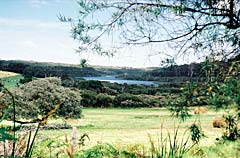
The weather is not 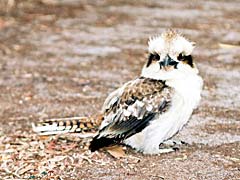 warm
any more. We had a rainy day which made the Southern ocean next to our camping
in Walpole appear very uninviting and austere. Our neighbors on the camping
assure us that normally around this time of year you can swim very nice in the
protected ocean inlet only 20 meters further on. Since the weather forecast
for the next days is bad we aren’t particularly happy with this information.
When you want
warm
any more. We had a rainy day which made the Southern ocean next to our camping
in Walpole appear very uninviting and austere. Our neighbors on the camping
assure us that normally around this time of year you can swim very nice in the
protected ocean inlet only 20 meters further on. Since the weather forecast
for the next days is bad we aren’t particularly happy with this information.
When you want 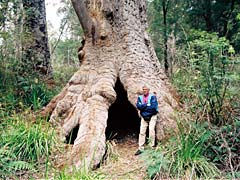 rain,
gray skies and cold wind you don’t have to travel (at least, when you live in
Holland). In between rain showers we pitch our tent, helped by three kookaburras.
First we thought they wanted something to eat, but no, they are just very interested.
One sits on the ground close to Jac, another lands on one of the flexible sticks
used to keep the tent up, just as I’m busy handling it. At last al three sit
closely together on the top of the opened backdoor of our car, obviously wondering
‘What’s the hurry?’. In Australia not only the people are annoyingly relaxed.
rain,
gray skies and cold wind you don’t have to travel (at least, when you live in
Holland). In between rain showers we pitch our tent, helped by three kookaburras.
First we thought they wanted something to eat, but no, they are just very interested.
One sits on the ground close to Jac, another lands on one of the flexible sticks
used to keep the tent up, just as I’m busy handling it. At last al three sit
closely together on the top of the opened backdoor of our car, obviously wondering
‘What’s the hurry?’. In Australia not only the people are annoyingly relaxed.
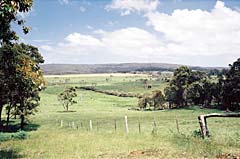
We see our first wild kangaroos in the 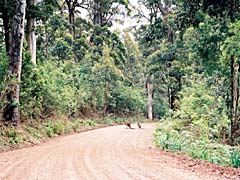 Walpole-Nornalup
NP while driving slowly in the middle of the forest over an unsealed road. A
mother and a young are sitting right in front of us in the middle of the road.
The mother quickly disappears in the bush, but the young kangaroo is curious
and stays put. When I open the door to make a picture he thinks it wiser to
create some more distance between us but goes on watching us. His mother joins
him and both stand looking at us. The dark green of the trees, the red of the
gravel of the unsealed road and the red brown of the kangaroos make an interesting
picture.
Walpole-Nornalup
NP while driving slowly in the middle of the forest over an unsealed road. A
mother and a young are sitting right in front of us in the middle of the road.
The mother quickly disappears in the bush, but the young kangaroo is curious
and stays put. When I open the door to make a picture he thinks it wiser to
create some more distance between us but goes on watching us. His mother joins
him and both stand looking at us. The dark green of the trees, the red of the
gravel of the unsealed road and the red brown of the kangaroos make an interesting
picture.
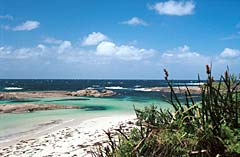 From
Walpole we drive east, to Albany. En route we stopover at ‘Peaceful Bay’, an
indeed peaceful bay, protected by granite rocks from the ocean, with very white
sand and water that varies from transparent light green to solid green blue.
The wind is cold but the sun shines and life is good. Further on we visit William
Bay NP with its ‘Green Pool’ and ‘Elephant rocks’. It is deserted except for
two fairy terns and of course the elephant rocks. The terns drill small holes
in the otherwise spotless beach,
From
Walpole we drive east, to Albany. En route we stopover at ‘Peaceful Bay’, an
indeed peaceful bay, protected by granite rocks from the ocean, with very white
sand and water that varies from transparent light green to solid green blue.
The wind is cold but the sun shines and life is good. Further on we visit William
Bay NP with its ‘Green Pool’ and ‘Elephant rocks’. It is deserted except for
two fairy terns and of course the elephant rocks. The terns drill small holes
in the otherwise spotless beach, 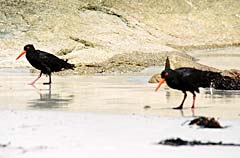 put
their long red beaks in each hole and slowly pull extensive streamers of a kind
of seaweed out of the hole, which they eat. I photograph the terns, the beach
and of course the elephant rocks, who look from down here a lot like a flock
of elephants coming out of the ocean. At least, that is my opinion. Jac strongly
disagrees with the Australian tendency of naming lifeless rocks like animals
and then telling tourist they should go and see this
put
their long red beaks in each hole and slowly pull extensive streamers of a kind
of seaweed out of the hole, which they eat. I photograph the terns, the beach
and of course the elephant rocks, who look from down here a lot like a flock
of elephants coming out of the ocean. At least, that is my opinion. Jac strongly
disagrees with the Australian tendency of naming lifeless rocks like animals
and then telling tourist they should go and see this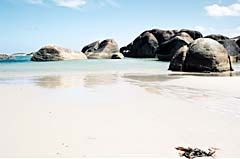 interesting animal rock. Anyway, he just sees rocks and no elephants. After
closer questioning he is willing to agree that the place is beautiful, pff…
We climb the rocks from the path behind, not difficult but on the beach side
we suddenly are high above the sand. The wind from the ocean is very strong
and I have to stand unyielding leaning against the wind to prevent being blown
away. ‘Blown by the wind’ sounds very romantic but isn’t in this situation.
interesting animal rock. Anyway, he just sees rocks and no elephants. After
closer questioning he is willing to agree that the place is beautiful, pff…
We climb the rocks from the path behind, not difficult but on the beach side
we suddenly are high above the sand. The wind from the ocean is very strong
and I have to stand unyielding leaning against the wind to prevent being blown
away. ‘Blown by the wind’ sounds very romantic but isn’t in this situation.
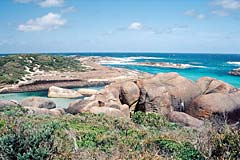
Albany is, like all small 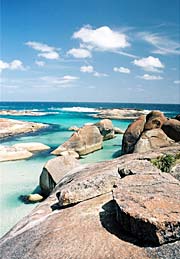 Australian
towns, very spread out with wide roads, more than enough parking space and one,
maximum two, storied houses with gardens. Not much fun to photograph, no special
features and it is already difficult just to get enough road and houses on the
picture to create the suggestion of a town! In Europe we have plenty of picturesque,
centuries old villages cozily fitted in valleys or in between a mountain and
the sea or even on top of a mountain. Roads are just big enough to accommodate
a hand-pulled cart or sometimes a carriage. Last year in Italy we saw so many
beautiful antique villages that somehow I thought this is normal. Even in Holland
we have very nice villages, of course not situated against or on top of mountains,
but we have a lot of water outside and inside the villages to make up for the
mountains. So don’t expect to much of the towns in Australia, at least there
are no parking problems and you won’t get lost in illogical winding tiny roads.
Australian
towns, very spread out with wide roads, more than enough parking space and one,
maximum two, storied houses with gardens. Not much fun to photograph, no special
features and it is already difficult just to get enough road and houses on the
picture to create the suggestion of a town! In Europe we have plenty of picturesque,
centuries old villages cozily fitted in valleys or in between a mountain and
the sea or even on top of a mountain. Roads are just big enough to accommodate
a hand-pulled cart or sometimes a carriage. Last year in Italy we saw so many
beautiful antique villages that somehow I thought this is normal. Even in Holland
we have very nice villages, of course not situated against or on top of mountains,
but we have a lot of water outside and inside the villages to make up for the
mountains. So don’t expect to much of the towns in Australia, at least there
are no parking problems and you won’t get lost in illogical winding tiny roads.
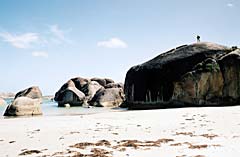
Close to Albany we visit the  wild
scenery of Torndirrup NP. We go to see a sleeping blow hole (the tide is not
right) and the ‘natural bridge’. I ignore some mumbled remarks of Jac who seems
not only to object to animal rocks (Albany features a ‘Dog Rock’, closely resembling
a Labrador, Jac insists on calling the rock ‘The Chicken’…) but also to ‘natural
bridges’. I make the obliged picture and watch a daring tourist, young and of
course male, jumping higher and higher on the middle of the bridge. As a rule
every ‘natural bridge’ collapses sometime and you can always hope that time
will be now.
wild
scenery of Torndirrup NP. We go to see a sleeping blow hole (the tide is not
right) and the ‘natural bridge’. I ignore some mumbled remarks of Jac who seems
not only to object to animal rocks (Albany features a ‘Dog Rock’, closely resembling
a Labrador, Jac insists on calling the rock ‘The Chicken’…) but also to ‘natural
bridges’. I make the obliged picture and watch a daring tourist, young and of
course male, jumping higher and higher on the middle of the bridge. As a rule
every ‘natural bridge’ collapses sometime and you can always hope that time
will be now.
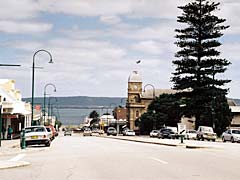 From
Albany we drive 400 kilometers east to Esperance. In between we want to visit
Fitzgerald River NP, but it is raining heavily and to prevent the spread of
‘die rot’ the park has been closed. At the south side of the park we try again,
but also here the entrance is closed. The heavy rain has stopped, but the strong
wind is very cold and the sky is gray. We walk to the beach, tiny plants are
blown away by the wind and the ocean looks unforgiving. In Hopetoun,
From
Albany we drive 400 kilometers east to Esperance. In between we want to visit
Fitzgerald River NP, but it is raining heavily and to prevent the spread of
‘die rot’ the park has been closed. At the south side of the park we try again,
but also here the entrance is closed. The heavy rain has stopped, but the strong
wind is very cold and the sky is gray. We walk to the beach, tiny plants are
blown away by the wind and the ocean looks unforgiving. In Hopetoun, 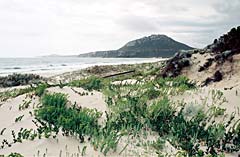 a
close by town, we find a café where we drink a beer to console ourselves.
Some locals, optimistically clothed in short trousers and sleeveless t-shirts,
barefooted, gather shivering around the lighted fire. Other tourist, a couple
from Austria, intended to spend this week at the beach as a relaxing end of
a close packed holiday. They cheer themselves up with a lot of alcohol while
looking reproachfully through the big windows at the angry ocean. Everybody
ensures us the weather is normally beautiful at this time of the year: just
not tó hot. It certainly is not tó hot, we agree.
a
close by town, we find a café where we drink a beer to console ourselves.
Some locals, optimistically clothed in short trousers and sleeveless t-shirts,
barefooted, gather shivering around the lighted fire. Other tourist, a couple
from Austria, intended to spend this week at the beach as a relaxing end of
a close packed holiday. They cheer themselves up with a lot of alcohol while
looking reproachfully through the big windows at the angry ocean. Everybody
ensures us the weather is normally beautiful at this time of the year: just
not tó hot. It certainly is not tó hot, we agree.

Esperance is  the
end of our tour round the south west coast of West Australia. Esperance, also
called the ‘Bay of Isles’ and named ‘Kepa Kurl’ by the aboriginals (the place
where the water lies down like a boomerang), was first visited in 1627 by our
own Dutch vessel “Gulde Zeepaard” under the command of Pieter Nuyts. They passed
through the Archipelago but did not actually land. The French landed here in
1792, seeking shelter from a storm. One of that ships was called “L’Esperance”.
Esperance has a spectacular coast: steep cliffs falling down on a small stroke
of sparkling white sand, the water unbelievable
the
end of our tour round the south west coast of West Australia. Esperance, also
called the ‘Bay of Isles’ and named ‘Kepa Kurl’ by the aboriginals (the place
where the water lies down like a boomerang), was first visited in 1627 by our
own Dutch vessel “Gulde Zeepaard” under the command of Pieter Nuyts. They passed
through the Archipelago but did not actually land. The French landed here in
1792, seeking shelter from a storm. One of that ships was called “L’Esperance”.
Esperance has a spectacular coast: steep cliffs falling down on a small stroke
of sparkling white sand, the water unbelievable clear with shades of blue and green that would seem a little overdone on a painting.
Our camping – completely Jac approved with clean toilets (= antless, although
I saw a spider with a big, compact body and extremely large, hairy legs nesting
in between stones in the wall, I wondered if it possibly was a jumping spider),
warm showers and a fully equipped camper kitchen – is close to the center of
Esperance and of course close to the sea – already we are getting spoiled. It
is starting to be cold, but next to the kitchen we sit protected from the wind,
enjoying a whiskey while looking at the spectacular sunset with aggressively
yellow coloring clouds, promising not much good…
clear with shades of blue and green that would seem a little overdone on a painting.
Our camping – completely Jac approved with clean toilets (= antless, although
I saw a spider with a big, compact body and extremely large, hairy legs nesting
in between stones in the wall, I wondered if it possibly was a jumping spider),
warm showers and a fully equipped camper kitchen – is close to the center of
Esperance and of course close to the sea – already we are getting spoiled. It
is starting to be cold, but next to the kitchen we sit protected from the wind,
enjoying a whiskey while looking at the spectacular sunset with aggressively
yellow coloring clouds, promising not much good…

Back to Virtual Traveling home
 Huge
forests with towering trees stretch endlessly out around Pemberton in the uttermost
South West of Australia. At least, to us it looks endlessly but as a result
of the activities of the timber industry there is only a fraction of the trees
left. Luckily in the last century trees have been planted also, the Beedelup
NP for example was totally destroyed but regrown in the last 100 years. In Pemberton,
the center of the logging industry, a heated discussion is ongoing between the
logging industry and environmental activists. The timber industry – from which
this area is for a large part economically dependent – claims their low impact
logging policy ensures the continuance of the forests. The environmental activists
try to protect the remaining old-growth forests and explain it takes centuries
to recreate what is destroyed. You simply cannot replace
Huge
forests with towering trees stretch endlessly out around Pemberton in the uttermost
South West of Australia. At least, to us it looks endlessly but as a result
of the activities of the timber industry there is only a fraction of the trees
left. Luckily in the last century trees have been planted also, the Beedelup
NP for example was totally destroyed but regrown in the last 100 years. In Pemberton,
the center of the logging industry, a heated discussion is ongoing between the
logging industry and environmental activists. The timber industry – from which
this area is for a large part economically dependent – claims their low impact
logging policy ensures the continuance of the forests. The environmental activists
try to protect the remaining old-growth forests and explain it takes centuries
to recreate what is destroyed. You simply cannot replace trees that are 500 years old. Furthermore, by killing the trees you also destroy
the life underneath, protected by the trees. The trees grow up to more than
60 meters and every part has its specific plants, animals and birds. The forests
consist of jarrah, marri and karri trees – please don’s ask which is which.
We have been studying the differences explained on informative signs on short
educational walks in different NP’s, but especially the difference between so-called
red karri trees (the straightest, highest trees) and red tingle (id) eludes
me. I even thought these two different names where intermittently used for the
same kind of tree, but this doesn’t seem to be the case. It are both eucalyptus
trees? If you know the distinction, please e-mail me!
trees that are 500 years old. Furthermore, by killing the trees you also destroy
the life underneath, protected by the trees. The trees grow up to more than
60 meters and every part has its specific plants, animals and birds. The forests
consist of jarrah, marri and karri trees – please don’s ask which is which.
We have been studying the differences explained on informative signs on short
educational walks in different NP’s, but especially the difference between so-called
red karri trees (the straightest, highest trees) and red tingle (id) eludes
me. I even thought these two different names where intermittently used for the
same kind of tree, but this doesn’t seem to be the case. It are both eucalyptus
trees? If you know the distinction, please e-mail me!



















